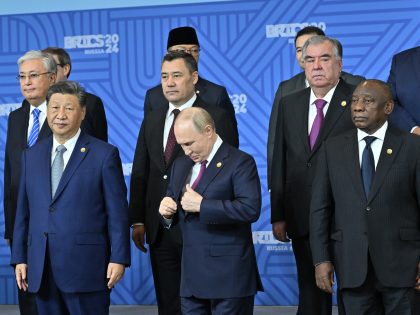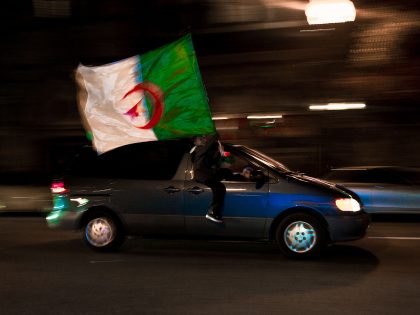The Congolese Burden
'Beauté Congo' wonderfully represents Congolese contemporary art, yet fails to completely evade European colonial baggage.

'Kiese na Kiese' (détail)
The exhibition, “Beauté Congo-1926-2015-Congo Kitoko” has been on view at the Cartier Foundation in Paris since July. The international press has showered the exhibition with the kind of attention many museums can only dream of, but reviews demonstrate how difficult it is to disassociate Conradian imagery from public perceptions of the Congo. Reviewers have hailed the exhibition as “brightly coloured and musical” (le Monde) with “luscious” art “leaping” from the walls (New York Times). The Wall Street Journal, however, takes the proverbial Conradian cake by noting “only the most fleeting sense of Conradian heart of darkness”. Although the exhibition represents a laudable attempt at reframing the representations of Congo through the history of its modern art, it nonetheless fails to fully escape the archetypes that burden us when it comes to Congo.
The course through the exhibition takes visitors backward in time, from contemporary artists to the ‘origin’ of modern art in Congo. The first space is dedicated to a group of young Congolese artists training their attention on the historical and environmental dimensions of Congolese city and landscapes and the people who populate them. The heart of the exhibition lies in the next section which presents the popular painters, active since the 1970’s. The paintings in these aisles are the works the visitor is most likely to be familiar with: bright, often large paintings that focus on subjects including Kinshasa’s flamboyant street life, the politics of personal relations and wealth, and the position of Congo in the world. The exhibition hinges on this section, with the work of the young artists positioned as the legacy of the popular painters and the downstairs rooms—with sections on Congolese photography of the 1950’s and ’60’s, the Academy of Indigenous Art in Elisabethville and the so-called ‘pre-cursors’ to modern art in Congo, positioned as historical predecessors.
While the exhibition has much to recommend it (seeing many of these works in person alone is worth the trip to Paris) it also serves as a reminder of the difficulties of dismantling colonial narratives about modern art. Although visitors are encouraged by staff to follow an ‘anti-chronological’ course through the exhibition, it in fact affirms a particular colonial story about the origin of modern Congolese art, one that places the starting point with the ‘discovery’ of local artists Albert and Antoinette Lubaki and Djilatendo by colonial official Georges Thiry and their promotion in Europe by Gaston-Denys Périer, an employee of the colonial ministry in Brussels. Predictably, the exhibition situates the Academy of Indigenous Art in Elisabethville, where Congolese students were encouraged to create works that were ‘African’ in inspiration, as the next step in this development. This particular genealogy repeats a narrative about Congolese modern art that emerged during the colonial era: Thiry and Périer saw themselves as the discoverers of Congolese modern art, and by the late 1950’s the colonial establishment attributed to the Academy of Elisabethville a similar influence. Beauté Congo does nothing to dismantle these assumptions; instead it endorses them. Not only does the exhibition’s narrative about the origin of modern Congolese art privilege the influence of European actors, spaces and contexts, it does so to the detriment of other possible genealogies.
An alternative narrative of Congolese modern art would include spaces and actors that typically fall outside of (Western) origin narratives of fine art, such as commercial activities like sign painting and so-called ‘tourist’ or ‘airport’ art. New research acknowledges the latter as a field of production driven by significant creative change. In Congo economic conditions forced modern art and commercial applications of artistic practices to go hand in hand. The role of Congolese autodidactic artists in the 1940’s and 1950’s is also likely to be important (particularly given the fact that many of the popular painters are autodidacts) although their activities and work, given our current historiographical perspective, are harder to track.
Despite that fact that the exhibition attempts to develop a presentation of African art that transcends the typical anonymous and muted exhibitions of ‘traditional’ art, it has at least one uncomfortable aspect in common with these exhibitions: the ownership of the objects on display. With seemingly only one exception, all of the works on display are Western-owned. As such, the exhibition serves as a reminder of how little the art economy of the Congo and its patterns of ownership have changed. The late Congolese art critic Celestin Badi-banga Ne Mwine in the early 1990’s lamented that “in the case of modern art, the country knew an exodus equal to that in traditional art. (…) Can we imagine in the future some kind of partial restitution of our modern art works?”. In invoking ‘restitution’, Badi-Banga references the decades-long entanglement between Congo and Belgium over cultural restitution and museum collections of traditional art. This issue appears to have recently found a new protagonist in the figure of Sindika Dokolo—not coincidentally the only non-Western owner one of the paintings in Beauté Congo. I mention this context not as a demand for the immediate return of these works to Congo, but as a reminder of the continued influence of the colonial roots of the African art market.
The commercial market in Congolese art lives right beneath the surface in this exhibition: after all, its organizer, André Magnin, owner of MAGNIN-A gallery in Paris, represents many of the contemporary artists involved. Part of the explanation for the deeply unequal patterns of ownership of modern art lie with the country’s steep economic decline from the mid-1970’s forward. While a domestic market evaporated, the popular painters oriented themselves towards expat and foreign markets. Describing these patterns of ownership only as the holdovers of colonial and neo-colonial structures, however, would be far too easy. Zaire’s own national museum institute was unable to collect much work from the popular painters for political reasons, despite the enthusiasm of its staff. The Mobutu regime, which founded and funded the institute, was none too pleased with the popular painters’ political and societal commentary and their rising popularity, preferring to promote a different, academic modern art as the representative of its national culture. As a result, the museum repository that could have kept some of these paintings in the country, failed to do so.
In this exhibition, we see young Congolese artists who explicitly address and position themselves against and beyond the stereotypical representations of Congo as an exotic place of darkness, violence, and disfunction. The origin narrative presented, however, and the uneven patterns of possession, counteract these messages by yet again placing Congo in a Eurocentric narrative.



















